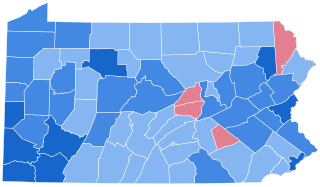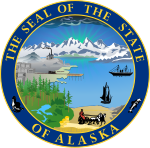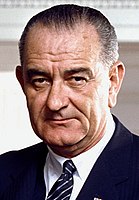
The 1964 United States presidential election was the 45th quadrennial presidential election. It was held on Tuesday, November 3, 1964. Incumbent Democratic President Lyndon B. Johnson defeated Republican Senator Barry Goldwater in a landslide victory. Johnson was the fourth and most recent vice president to succeed the presidency following the death of his predecessor and win a full term in his own right. Johnson won the largest share of the popular vote for the Democratic Party in history, 61.1%, and the highest for any candidate since the advent of widespread popular elections in 1824.

The 1964 United States Senate elections were held on November 3. The 33 seats of Class 1 were contested in regular elections. Special elections were also held to fill vacancies. They coincided with the election of President Lyndon B. Johnson by an overwhelming majority, to a full term. His Democratic Party picked up a net two seats from the Republicans. As of 2023, this was the last time either party has had a two-thirds majority in the Senate, which allowed the Senate Democrats to override a veto, propose constitutional amendments, or convict and expel certain officials without any votes from Senate Republicans. However, internal divisions would have prevented the Democrats from having done so. The Senate election cycle coincided with Democratic gains in the House in the same year.

The 1964 United States presidential election in Idaho took place on November 3, 1964, as part of the 1964 United States presidential election, which was held throughout all 50 states and Washington, D.C. Voters chose four representatives, or electors to the Electoral College, who voted for president and vice president.

The 1964 United States presidential election in Arizona took place on November 3, 1964, as part of the 1964 United States presidential election, which was held throughout all 50 states and D.C. Voters chose five representatives, or electors to the Electoral College, who voted for president and vice president.

The 1964 United States presidential election in Rhode Island took place on November 3, 1964, as part of the 1964 United States presidential election, which was held throughout all 50 states and D.C. Voters chose four representatives, or electors to the Electoral College, who voted for president and vice president.

The 1964 United States presidential election in Georgia took place on November 3, 1964, as part of the 1964 United States presidential election, which was held on that day throughout all 50 states and The District of Columbia. Voters chose 12 representatives, or electors to the Electoral College, who voted for president and vice president.

The 1964 United States presidential election in Pennsylvania took place on November 3, 1964, and was part of the 1964 United States presidential election. Voters chose 29 representatives to the Electoral College, who voted for president and vice president. Pennsylvania overwhelmingly voted for the Democratic nominee, President Lyndon B. Johnson, over the Republican nominee, Senator Barry Goldwater. Johnson won Pennsylvania by a margin of 30.22%. Apart from William Howard Taft in 1912, Goldwater's 34.7% of the vote is easily the worst showing for a Republican in the state since the party was founded. Even relative to Johnson's popular vote landslide, Pennsylvania came out as 7.64% more Democratic than the nation at-large; the only occasion under the current two-party system that the state has been more anomalously Democratic than this was in Ronald Reagan's 1984 landslide.

The 1976 United States presidential election in Vermont took place on November 2, 1976, as part of the 1976 United States presidential election which was held throughout all 50 states and the District of Columbia. Voters chose three representatives, or electors to the Electoral College, who voted for president and vice president.

The 1964 United States presidential election in New York took place on November 3, 1964, as part of the 1964 United States presidential election in which all 50 states plus the District of Columbia participated. New York voters chose 43 electors to represent them in the Electoral College via a popular vote pitting incumbent Democratic President Lyndon B. Johnson and his running mate, President pro tempore of the Senate Hubert Humphrey, against Republican challenger and Senator Barry Goldwater from Arizona and his running mate and Chair of the Republican National Committee, William E. Miller.

The 1920 United States presidential election in New York took place on November 2, 1920. All contemporary 48 states were part of the 1920 United States presidential election. Voters chose 45 electors to the Electoral College, which selected the president and vice president.

The 1964 United States presidential election in Massachusetts took place on November 3, 1964, as part of the 1964 United States presidential election, which was held throughout all 50 states and D.C. Voters chose 14 representatives, or electors to the Electoral College, who voted for president and vice president.

The 1968 United States presidential election in Vermont took place on November 5, 1968, as part of the 1968 United States presidential election which was held throughout all 50 states and the District of Columbia. Voters chose three representatives, or electors to the Electoral College, who voted for president and vice president.

The 1964 United States presidential election in Vermont took place on November 3, 1964, as part of the 1964 United States presidential election in which all 50 states plus the District of Columbia participated. Vermont voters chose 3 electors to represent them in the Electoral College via a popular vote pitting incumbent Democratic President Lyndon B. Johnson and his running mate, Senate Majority Whip Hubert Humphrey, against Republican challenger and Senator Barry Goldwater from Arizona and his running mate and Chair of the Republican National Committee, William E. Miller. It was the first time in Vermont's history that the state voted for the Democratic Party.

The 1936 United States presidential election in Vermont took place on November 3, 1936, as part of the 1936 United States presidential election which was held throughout all contemporary 48 states. Voters chose three representatives, or electors to the Electoral College, who voted for president and vice president.

The 1964 United States presidential election in New Jersey took place on November 3, 1964. All 50 states and the District of Columbia, were part of the 1964 United States presidential election. Voters chose 17 electors to the Electoral College, which selected the president and vice president.

The 1964 United States presidential election in New Hampshire took place on November 5, 1964, as part of the 1964 United States presidential election, which was held throughout all 50 states and D.C. Voters chose four representatives, or electors to the Electoral College, who voted for president and vice president.

The 1964 United States presidential election in Virginia took place on November 3, 1964. All 50 states and the District of Columbia were part of the 1964 United States presidential election. Virginia voters chose 12 electors to the Electoral College, which selected the president and vice president of the United States.

The 1964 United States presidential election in Texas was held on November 3, 1964, as part of the 1964 United States presidential election. The Democratic Party candidate, incumbent President Lyndon B. Johnson, comfortably won his home state of Texas with 63.32% of the vote against the Republican Party candidate, Senator Barry Goldwater of Arizona, who won 36.5%, giving him the state's 25 electoral votes and a victory margin of 26.8 percentage points. Johnson won the 1964 election in a landslide, carrying 44 states plus the District of Columbia, which participated for the first time. Goldwater only carried his home state of Arizona, along with five Deep South states which had been historically Democratic, but defected to the Republican Party due to the Democratic Party’s support for civil rights. Due to its status as Johnson's home state, in 1964, Texas was the most Democratic of the 11 states of the former Confederacy and the only one which leaned more Democratic than the nation at-large.

The 1964 United States presidential election in Maine took place on November 3, 1964, as part of the 1964 United States presidential election, which was held throughout all fifty states and D.C. Voters chose four representatives, or electors to the Electoral College, who voted for president and vice president.

The 1964 United States presidential election in West Virginia took place on November 3, 1964, as part of the 1964 United States presidential election. West Virginia voters chose seven representatives, or electors, to the Electoral College, who voted for president and vice president.


























